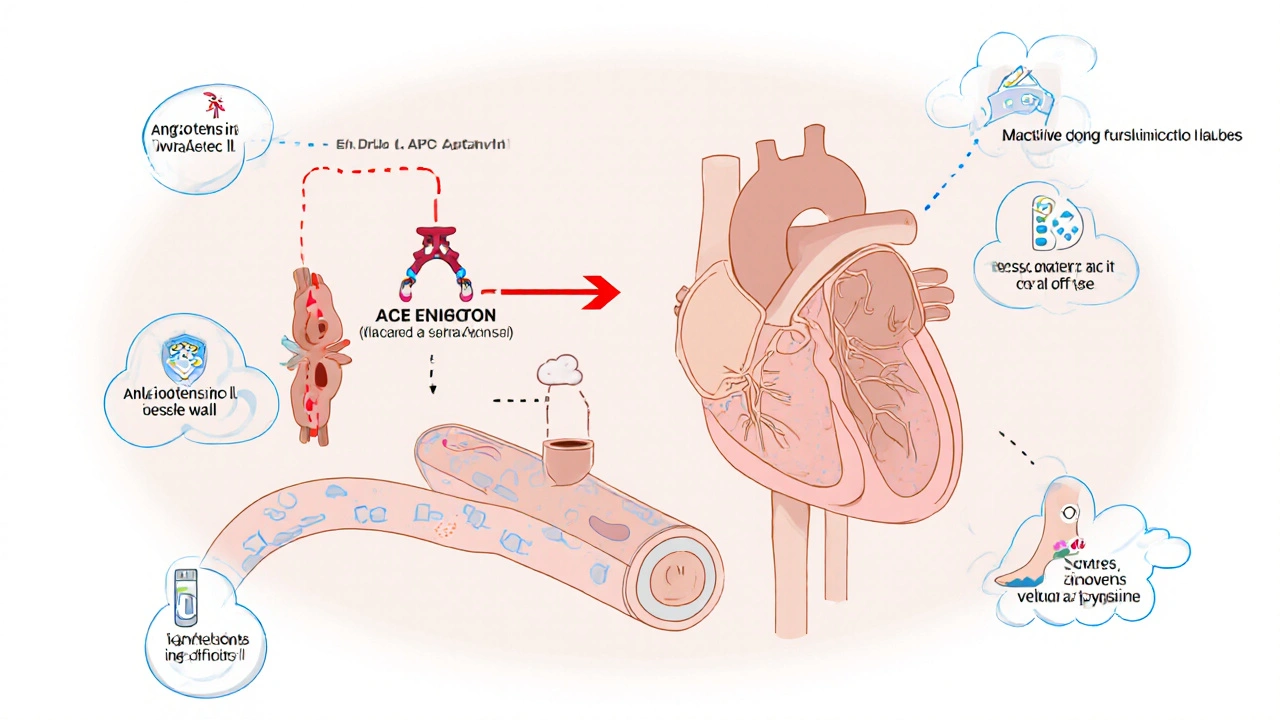Blood Pressure Medication Selector
Recommended Medication
Your personalized recommendation will appear here after selecting options.
Medication Comparison
Vasotec (Enalapril)
ACE Inhibitor • Low cost • Proven efficacy
Dry Cough ~5-10% Elevated PotassiumLisinopril
ACE Inhibitor • Higher ceiling dose
Similar cough risk Occasional RashRamipril
ACE Inhibitor • Longer half-life
Lower cough incidence Taste DisturbancesLosartan
ARB • No cough
Minimal cough Hyperkalemia RiskAmlodipine
Calcium Channel Blocker • Once-daily
Ankle Swelling HeadacheHydrochlorothiazide
Thiazide Diuretic • Very affordable
Low Potassium Gout Flare-upsQuick Takeaways
- Vasotec (enalapril) is a well‑tolerated ACE inhibitor for hypertension and heart failure.
- Key alternatives include other ACE inhibitors (lisinopril, ramipril), an ARB (losartan), a calcium‑channel blocker (amlodipine) and a thiazide diuretic (hydrochlorothiazide).
- Choosing the right drug hinges on kidney function, cough risk, cost and how often you want to take a pill.
- Australian PBS prices in 2025 make generic enalapril one of the cheapest options.
- Switching drugs should be done under a doctor’s guidance to avoid sudden blood‑pressure spikes.
What Is Vasotec (Enalapril)?
Vasotec is the brand name for enalapril, an angiotensin‑converting enzyme (ACE) inhibitor approved in 1984. It relaxes blood vessels by blocking the conversion of angiotensin I to the powerful vasoconstrictor angiotensin II. The result is lower systolic and diastolic pressure, reduced workload on the heart, and slower progression of kidney damage in diabetics.
Typical starting doses are 5mg once daily for hypertension, with a usual maintenance range of 10‑20mg per day. For heart‑failure patients, doctors may begin at 2.5mg twice daily and titrate up based on symptoms and blood‑pressure response.
For many patients, Vasotec offers a balance of efficacy, once‑daily dosing, and low PBS cost (about AU$2.50 for a 30‑day supply of the generic version in 2025).
How Enalapril Works - The ACE‑Inhibitor Mechanism
The renin‑angiotensin‑aldosterone system (RAAS) controls fluid balance and vessel tone. When the kidneys sense low blood flow, they release renin, which converts angiotensinogen to angiotensin I. ACE then turns angiotensin I into angiotensinII, which narrows arteries and prompts the adrenal glands to release aldosterone, retaining sodium and water.
Enalapril blocks ACE, so less angiotensinII forms. Blood vessels stay relaxed, blood pressure drops, and the heart doesn’t have to pump as hard. This also reduces the stress on the kidneys, a key benefit for diabetic patients.
Common Alternatives to Vasotec
When a doctor considers a switch, they usually look at drugs that either belong to the same class (other ACE inhibitors) or act on a different point in the RAAS pathway. Below are the most frequently prescribed alternatives in Australia.
Lisinopril
Lisinopril is another ACE inhibitor, marketed under brand names such as Zestril and Lisodur. Its dosing range (5‑40mg daily) is similar to enalapril, but it’s often preferred for patients who need a higher ceiling dose because the 40mg strength can be useful in resistant hypertension.
Ramipril
Ramipril provides a slightly longer half‑life, allowing some clinicians to prescribe it once daily for heart‑failure patients who struggle with twice‑daily dosing. Typical doses start at 2.5mg daily and can be increased to 10mg.
Losartan
Losartan belongs to the angiotensin‑II receptor blocker (ARB) class. It blocks the receptor that angiotensinII binds to, achieving a similar blood‑pressure‑lowering effect without inhibiting ACE. This makes it a go‑to option for patients who develop a persistent dry cough on ACE inhibitors. Standard dosing is 50mg once daily, up to 100mg.
Amlodipine
Amlodipine is a calcium‑channel blocker that relaxes arterial smooth muscle by inhibiting calcium influx. It’s often used when patients need additional control after an ACE inhibitor or when RAAS‑targeted drugs are contraindicated. Typical doses range from 5‑10mg once daily.
Hydrochlorothiazide
Hydrochlorothiazide (HCTZ) is a thiazide diuretic that reduces blood volume by increasing urinary salt and water excretion. It’s cheap (≈AU$1.20 per month) and works well in combination with an ACE inhibitor or ARB. Usual doses are 12.5‑25mg once daily.

Side‑Effect Profiles - What to Expect
All blood‑pressure drugs have trade‑offs. Below is a concise side‑effect snapshot for each alternative.
- Enalapril (Vasotec): dry cough (~5‑10% of users), elevated potassium, rare angio‑edema.
- Lisinopril: similar cough risk, occasional rash, mild dizziness.
- Ramipril: lower cough incidence than enalapril, but can cause taste disturbances.
- Losartan: minimal cough, possible dizziness, hyperkalemia in kidney disease.
- Amlodipine: ankle swelling, flushing, headache.
- Hydrochlorothiazide: increased urination, low potassium, gout flare‑ups.
Patients with a history of angio‑edema should avoid all ACE inhibitors and ARBs. Those with chronic kidney disease need careful monitoring of potassium and creatinine levels regardless of the chosen drug.
Cost Comparison (2025 PBS Prices - Australia)
| Drug | Typical Daily Dose | Monthly PBS Cost (AU$) | Key Advantage |
|---|---|---|---|
| Enalapril (Vasotec) | 10mg | 2.50 | Proven safety, inexpensive |
| Lisinopril | 20mg | 3.20 | Higher ceiling dose |
| Ramipril | 5mg | 3.00 | Longer half‑life |
| Losartan | 50mg | 4.10 | No cough |
| Amlodipine | 5mg | 5.00 | Excellent for isolated systolic hypertension |
| Hydrochlorothiazide | 25mg | 1.20 | Very cheap, good combo partner |
How to Choose the Right Option
Picking a blood‑pressure drug isn’t a one‑size‑fits‑all decision. Use the checklist below with your clinician.
- Kidney function: If eGFR is below 30ml/min, many ACE inhibitors need dose reduction; ARBs may be safer.
- Cough sensitivity: A persistent dry cough points toward an ARB like losartan.
- Cost constraints: Enalapril and hydrochlorothiazide are the cheapest PBS‑listed options.
- Need for once‑daily dosing: Amlodipine and losartan are convenient single‑pill regimens.
- Comorbidities: Diabetes with proteinuria benefits from an ACE inhibitor or ARB; gout patients may avoid thiazides.
When a switch is necessary, the typical protocol is a 24‑hour washout for ACE inhibitors before starting an ARB, to reduce the already low risk of angio‑edema.
Practical Tips for Starting or Switching
- Take your pill at the same time each day - morning works for most people.
- Monitor blood pressure twice a week for the first month after a change.
- Check serum potassium and creatinine after two weeks, then again at three months.
- If you feel dizzy, stand up slowly; this often signals an early‑morning dip.
- Never stop a medication abruptly without talking to your GP - sudden spikes can harm the heart.
Frequently Asked Questions
Can I take Vasotec and a thiazide diuretic together?
Yes. Combining an ACE inhibitor with a thiazide like hydrochlorothiazide often yields better blood‑pressure control and can offset the potassium‑raising effect of the ACE inhibitor.
Why do some people develop a cough on enalapril?
Enalapril blocks the breakdown of bradykinin, a peptide that can irritate the airway lining. The buildup triggers a dry, tickly cough in about 5‑10% of users.
Is losartan safer for people with a history of angio‑edema?
Losartan eliminates the ACE‑related increase in bradykinin, so the risk of angio‑edema is markedly lower. However, any ARB still carries a small residual risk, so doctors evaluate each case individually.
How often should I have my kidney function tested while on enalapril?
Check eGFR and serum potassium at baseline, then at two weeks after starting or changing dose, and again at three months. If stable, yearly monitoring is sufficient.
Can I switch from Vasotec to lisinopril without a washout period?
Since both are ACE inhibitors, you can transition directly, usually by stopping Vasotec and starting lisinopril the next day at an equivalent dose. Your doctor will adjust the dose based on blood‑pressure response.





16 Comments
Rhiane Heslop
The market of antihypertensives reflects a hierarchy of power. Enalapril claims superiority over generic ACE inhibitors. Nations that cling to brand names betray their own sovereignty. Choose wisely or remain subjugated.
Dorothy Ng
Enalapril, known as Vasotec, is an ACE inhibitor that reduces angiotensin‑II production. Compared to thiazide diuretics it generally has fewer metabolic side effects. However, patients with severe renal impairment may need dose adjustments. This guide outlines the key differences without unnecessary jargon.
Justin Elms
Hey folks, if you’re looking for a simple rundown just remember enalapril works by relaxing blood vessels. It’s often a first‑line choice because it’s well tolerated and cheap. For people who can’t handle diuretics it’s a solid backup. Stay positive and keep checking your numbers!
Jesse Stubbs
Another boring drug comparison, yawn.
Melissa H.
Did anyone notice that the dosage charts skip the 5 mg option? 🤔 That could confuse new patients. Also the side‑effect list seems to downplay cough frequency 😒.
Edmond Abdou
Good catch! The missing 5 mg can be important for titration 😊. Doctors often start low and go slow to avoid hypotension. Adding that note would make the guide more user‑friendly.
Sydnie Baker
While the comparative tableau is commendably exhaustive, the lexicon employed borders on the prosaic. One might elevate the discourse by integrating terms such as “pharmacokinetic profile” and “renin‑angiotensin modulation.” Moreover, the segment on adverse events would benefit from a more erudite articulation.
Benjie Gillam
i totally get ur point but the guide needs sum real talk. the enalapril’s half‑life is about 11 hrs which is pretty decent. u can’t just dump fancy words and ignore how patients actually feel about cough side effects. that’s defintely a gap.
Naresh Sehgal
Listen up! If you’re still using those outdated beta‑blocker combos you’re doing yourself a disservice. Enalapril offers a clean mechanism that outperforms many older drugs. Stop wasting time and switch to a proven ACE inhibitor now!
Poppy Johnston
Whoa, let’s keep it cool. Some folks do well on beta‑blockers, especially with certain heart conditions. It’s all about personalized care, not one‑size‑fits‑all. Appreciate the passion though!
Johnny VonGriz
Honestly, the guide does a solid job of laying out the pros and cons. I liked the side‑effect comparison table the most – it’s straight to the point. On the flip side, I wish there were more real‑world anecdotes from patients. Overall, good work!
Real Strategy PR
Such superficial analysis only serves the pharma agenda.
Doug Clayton
I hear the concerns about bias and it’s valid. The medical community should strive for transparency. Offering both clinical data and patient experiences would build trust. Thanks for opening this dialogue.
Michelle Zhao
The comparative evaluation of vasotec (enalapril) against alternative antihypertensive agents necessitates a rigorous methodological framework.
Firstly, the pharmacodynamic properties of enalapril, as an angiotensin‑converting enzyme inhibitor, merit consideration due to its direct impact on systemic vascular resistance.
In contrast, calcium‑channel blockers modulate intracellular calcium influx, offering a divergent mechanistic pathway.
Secondly, the safety profile of enalapril, particularly the incidence of cough and angioedema, should be weighed against the electrolyte disturbances commonly associated with thiazide diuretics.
Moreover, renal function stratification reveals that enalapril’s efficacy may be attenuated in patients with markedly reduced eGFR, necessitating dose adjustments or alternative therapy.
The cost‑effectiveness analysis further underscores the advantage of generic enalapril, which frequently presents at a lower price point than brand‑name alternatives.
It is also imperative to acknowledge patient adherence, as the once‑daily dosing schedule of enalapril can improve compliance relative to multiple‑dose regimens.
Conversely, some individuals experience a persistent dry cough, which may compromise adherence and thus diminish therapeutic outcomes.
Clinical guidelines from major cardiology societies generally endorse enalapril as a first‑line option for uncomplicated hypertension.
Nevertheless, comorbid conditions such as heart failure or diabetic nephropathy may influence the selection of a more tailored regimen.
The comparative literature demonstrates that combination therapy, integrating enalapril with a thiazide diuretic, can achieve superior blood pressure control in resistant cases.
Additionally, drug‑drug interactions must be scrutinized, especially when patients are concurrently prescribed non‑steroidal anti‑inflammatory agents.
Patient education regarding potential side effects remains a cornerstone of successful hypertension management.
In summary, while enalapril offers a compelling balance of efficacy, safety, and affordability, individual patient factors ultimately dictate the optimal therapeutic choice.
Future research should aim to elucidate the long‑term cardiovascular outcomes associated with enalapril compared to emerging therapeutic classes.
Eric Parsons
Your exposition is indeed thorough and aligns with current guideline recommendations. To complement your analysis, recent meta‑analyses suggest that enalapril combined with low‑dose thiazides reduces cardiovascular events more effectively than monotherapy. Additionally, monitoring serum potassium is advisable when patients are on concurrent potassium‑sparing agents. Incorporating these nuances can further enhance the guide’s utility for clinicians.
Mary Magdalen
Patriotic readers should be aware that foreign drug manufacturers often inflate prices for cheap ACE inhibitors like enalapril. Our own healthcare system deserves better deals, not the profiteering of overseas conglomerates. Push for home‑grown generic production now!